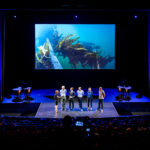
Now that ICAAC 2015 — the Interscience Conference on Antimicrobial Agents and Chemotherapy — is out of the way, the only thing standing between the American Society for Microbiology (ASM) and ASM Microbe 2016 is five more months of planning, organizing, and preparing for the great unknown.
ICAAC is one of two annual conferences that as of this year ASM is combining into ASM Microbe — an umbrella event that’s meant to appeal to the organization’s entire membership. ASM held the other annual conference, its General Meeting, for the final time in New Orleans last spring. ICAAC wrapped up at the San Diego Convention Center on Sept. 17–21.
“It was a great meeting, and we heard the same things that we did at the General Meeting,” said Kirsten Olean, CMP, CAE, ASM’s director of meetings. “There were people that are excited about the new concept [for ASM Microbe], and they just want to make sure that their content is still there and their science is still there. When we do hear concerns, that’s what we hear: Is it still going to have sessions on X or sessions on Y, or whatever it is that’s really important to them.”
ASM Microbe will take place in Boston on June 16–20, 2016. Convene is following Olean and her team as they figure out how to turn the General Meeting and ICAAC into one seamless conference — and keep all their attendees happy in the process.
SITE VISITS AND SPEAKERS
We first spoke to Olean about ASM Microbe in June, not long after the 2015 General Meeting. She discussed everything from the rationale behind the new meeting (falling attendance at ICAAC and the desire to create a unified program that speaks to ASM’s entire community); to the committee structure that’s evolved to manage it (a Steering Committee overseeing three program committees — for the General Meeting, ICAAC, and ASM Microbe’s Profession of Microbiology track); to basic logistics (10,000 to 12,000 attendees at the Boston Convention & Exhibition Center [BCEC], with additional meeting space at three hotels); to how ASM promoted the new conference at the General Meeting (with a town-hall information session, signage, and samples of the giant microbe models that will be part of ASM Microbe’s wayfinding).
When we caught up with Olean again at the beginning of November, she had a lot to report. She and two members of her team — one for logistics, another for exhibits — had done a site visit to Boston in August, along with their main contact at Freeman, ASM’s contractor. “What we needed to figure out was exactly where we were placing things,” Olean said. “We needed to know how many giant microbes we were going to create and exactly where all the lounges were going to be. Thinking about where we wanted human directionals. Thinking about the lightpost banners, and where we wanted to place banners on what streets [outside the venues]. Where we wanted to potentially do sidewalk clings, which is one of the things we’re hoping to do, if we get permission from the city, to help people navigate between all the properties.”
The timing of the visit was driven by ASM’s budget cycle for 2016 — Olean needed to have numbers in by the beginning of September. “It was great,” she said, “because now we have a floor plan of the convention center and the hotels that shows where everything is going to take place.” Olean was planning to return to Boston last month with her in-house meetings team, Freeman, and all of ASM’s other suppliers for a visit she called “the major one, where we’ll meet with the different departments of the convention center and go over details about catering, electrical, Internet — all the different areas that we need to make sure we understand what our needs are, what our costs are, what policies are in place.”
Another priority for Olean over the last few months has been to book ASM Microbe’s keynote speaker, who takes the stage halfway through the conference, on June 18. ASM had already locked in its traditional General Meeting and ICAAC general sessions, including the President’s Forum on “Viruses: Vital Members of Polymicrobial Communities”; the Antimicrobial Research Award Lecture, featuring Steering Committee Chair David C. Hooper, M.D., a professor of medicine at Harvard Medical School; the Maurice Hilleman/Merck Award Lecture, featuring Peter Palese, Ph.D., chair of the microbiology department at Mount Sinai Hospital in New York City; and the ICAAC Lecture, featuring Didier Pittet, M.D., director of the University Hospital of Geneva’s Infection Control Programme. At the time of our interview, Olean was halfway to securing her keynote. She had booked Richard Besser, M.D., chief health and medical editor for ABC News, to moderate the session, and had extended an invitation to a big name in microbiology to appear as the featured presenter. “If they decline our invitation,” Olean said, “then we will work with Richard Besser to develop another session where he’s interviewing somebody else in the field — something around the communication of science to the public.”
‘BRAINSTORMING AND DESIGNING’
Like ASM’s final General Meeting, ICAAC 2015 included a town-hall session about ASM Microbe that “nobody really came to,” Olean said. “We took that as a good sign.” There was similar branding for ASM Microbe at ICAAC as well, including giveaway microbe toys, those giant microbe wayfinders, and a Boston-themed photo stand. ASM traditionally has maintained a smaller presence on the ICAAC show floor than at the General Meeting because ICAAC, focused primarily on infectious diseases, tends to draw a number of non-ASM members. But “we did try to expand the booth for this year’s ICAAC,” Olean said, “to try and expand the presence of the Society there in anticipation of [ASM Microbe].”

Talking to attendees at ICAAC left Olean more convinced than ever that ASM needs to get the design of ASM Microbe exactly right — so both groups of attendees, from the General Meeting and ICAAC, find what they’re looking for at the new conference. To that end, in November, Olean’s team and Freeman got together at ASM headquarters in Washington, D.C., to “spend a day talking through all of the pieces we need to create,” Olean said. “A lot of what we’re creating for ASM Microbe are things that we haven’t done before. I’m sure they’re things that Freeman has done before, but not things that ASM has done.”
Freeman brought six people to the meeting — specialists in design, medical meetings, trade shows, and other areas. “It was a really, really interactive meeting,” said Greg Costello, senior client solutions manager for Freeman, “as far as ASM telling us what they planned to do in a space and then letting us come up with ideas as to how to design it — whether it’s a hub, whether it’s a membership booth, whether it’s the registration area in the north lobby.” As part of the daylong program, staff representatives from various ASM departments met with Freeman to “explain what they would like to see come 2016 in Boston,” Costello said. He added: “It was a full, compact day of brainstorming and designing.”
Olean particularly valued the experience of “sitting in a room and really spending time talking about it, having direct access to the designer and the graphics people, which we don’t usually. Usually all of that goes through your main contact. We can really get at what it is we’re trying to create, what outcomes we’re looking for.” She was hoping to see renderings and preliminary sketches from Freeman in time for the December site visit — and when we talked to Costello the week after the design meeting, that was already in the works. “Both ASM and Freeman left with a ton of great notes and ideas on how to move forward,” he said. “ASM has actually started to see some of those design features [from Freeman] in the last day or so. Just a first draft, first round of ‘Hey, here’s kind of what we thought you were thinking. How do you want us to move on from here?’”
For Freeman, it’s been “a lot of fun” to work with ASM on blending its two separate conferences — for which Freeman also served as contractor — into something entirely new. “It’s been an exciting process,” Costello said, “just trying to figure out how we’re going to make these two different but same segments in the microbiology industry into one, so it’s a community kind of feel when they get to Boston. So it’s actually one show, but you can have your own segment at the event. It’s been pretty neat.”
IN THE ABSTRACT
As ASM’s Kirsten Olean, CMP, CAE, works through the mechanics of merging the ASM General Meeting and ICAAC into one event, the question of how to handle abstracts has been a complicated one. ASM’s General Meeting and ICAAC each had its own poster process — each involving thousands of submissions — and bridging the two has proved challenging. “What were in the guidelines for the General Meeting and what were in the guidelines for ICAAC were different,” Olean said. “In some cases, completely opposite.”
This was important: Olean is expecting 5,000 posters at ASM Microbe. First, members of the General Meeting and ICAAC communities worked to reconcile the guidelines, narrowing the major differences between the two groups down to four issues and drafting a new set of guidelines. Olean’s team sent that to ASM Microbe’s Steering Committee, which is made up of leaders of the conference’s three program committees. An email discussion over the following week “got heated pretty quickly, not in a negative way,” yielding comments that a Steering Committee member synthesized into a second draft, which the Steering Committee eventually approved.
“We still have to figure out the abstract review, which is another place where the two groups have very different processes, in terms of how they review and rate the abstracts,” Olean said. “We have to tackle that one by conference call with the Steering Committee, because we know that one’s going to be more controversial and we really need to have a good, robust discussion about it.”
2017 AND BEYOND
With “I would say like 98 percent” of ASM Microbe’s education program already nailed down when we talked to Olean at the beginning of November, one of her major priorities was finalizing the guidelines for abstract submissions, which went live in mid-November. (See “In the Abstract,” p. 50.)
Another priority: Finalizing requirements for registration — including fees for the many workshops being offered at ASM Microbe — so Experient could build the system; premium member registration was scheduled to launch on Dec. 17, with full registration opening on Jan. 7. And, believe it or not, Olean is already planning to plan for ASM Microbe 2017, which will be held in New Orleans next June 1–5. She’s hoping to bring the Steering Committee together sometime this March “to talk about 2017 and beyond,” she said. “We need to figure out what the structure of [ASM Microbe] will look like for 2017. I have sketched out a potential schedule that is much more integrated and looks a little bit different than what we’ve got for 2016…. We want to bring that as just a starting point for this discussion: Not only what does the meeting look like, also how are we going to plan it?”
The goal is to blend ASM Microbe’s two main constituent groups — General Meeting and ICAAC — more and more each year, beginning with the new conference’s very committee structure. “We want to figure out what steps we take in ’17 in terms of the planning process to be more collaborative,” Olean said. “Ultimately what we want to get to is one program committee. How do we get there by ’18? Is it going to be ’19?”
Meanwhile, how is ’16 looking? A good early indicator of attendance is the number of abstracts submitted; that deadline is Jan. 12. Keep watching this space.



